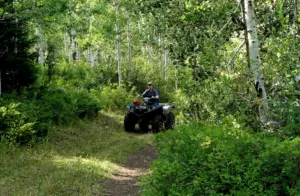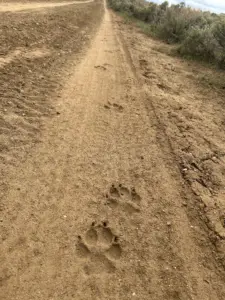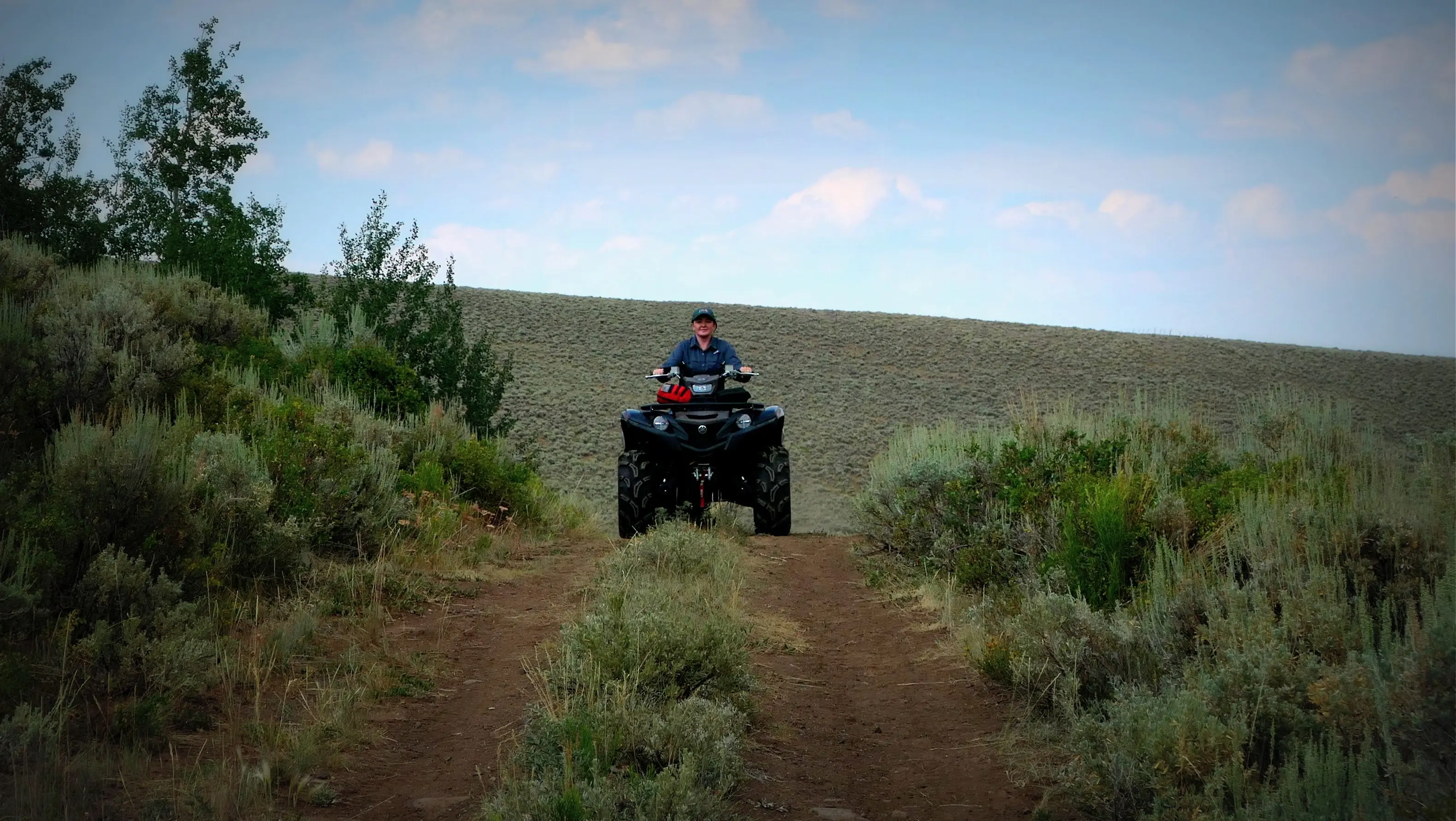
By Shannon Lukens.
UPDATE on Thursday, July 31, 2025. The Colorado Department of Agriculture has sent financials of the cost of the Range Riding program, upon request.
- FY 2024-25: total budget – $580,936
- FY 2025-26: total budget – $424,647
- CDA’s two non-lethal mitigation specialists each are paid $82,063.00 and range riding is only part of their job.
Range Riders have been employed throughout Colorado to help with non-lethal mitigation of wolves. Colorado Parks and Wildlife has ten range riders. The Colorado Department of Agriculture employs three range riders, one of whom is Shelby Neiberger, who grew up in Rangely. She is 30 years old.
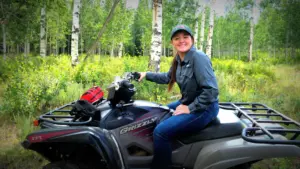
“Hello. I’m Shelby Neiburger. I work for the Colorado Department of Agriculture, and I am their Northwest Non-Lethal Mitigation Specialist. I’m also a full-time range rider for the state of Colorado. So, what we do when we’re range riding is we focus on areas of wolf activity currently. Wolves have been introduced into Colorado and are hanging around livestock. So our job is to try to protect the livestock and encourage the wolves to leave any areas where there’s a high density of livestock.”
Photo courtesy Shelby Neiberger.
Neiberger says they have many tools they use.
“We have thermal vision to watch the livestock at night. We’re listening for verbal or vocal cues from the livestock themselves because a lot of the times they will let you know if something is in the area that they’re not a fan of. We also use horses and ATVs. We have non-lethal hazing tools like the pepper ball launcher. You can chase wolves on a four-wheeler as long as you’re not making contact with them. Anybody is able to do that without a non-injurious, non-lethal hazing permit. We can use things like box lights or noise machines. It’s typically the things that people know about. We also get very creative and we come up with different ways, like placing stinky shirts in areas to create that human presence, and maybe marking a human territory to try to keep the wolves out of an area.”
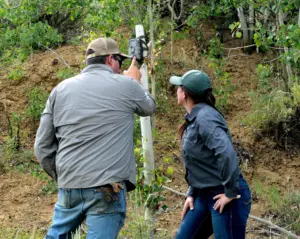
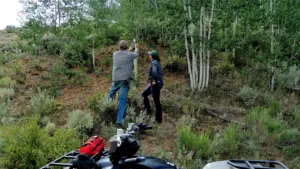
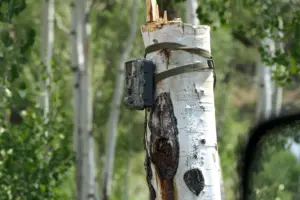
Neiberger has been on the VanValkenburg ranch where there is a confirmed pack of wolves, known as the One-Ear Pack. There are four adults, with a suspected set of possibly three pups. She and Adam VanValkenburg check game cameras throughout the property.
“They (the game cameras) let us know if they’re traveling alone or if they’re traveling as a pack. We got pictures of them packing back food to the dens, and a lot of the times it’s actually small things, like birds or marmots and stuff like that. So even though they do eat large ungulates, they do feast on smaller things as well.”
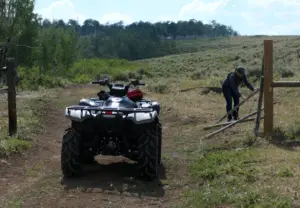
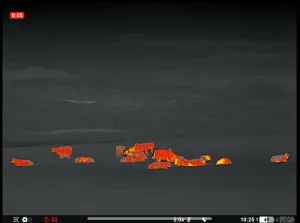
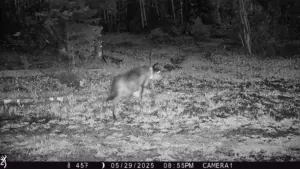
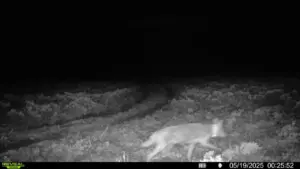
Photos courtesy Adam VanValkenburg.
Neiberger is out there alone at night. We asked if she is afraid of the wolves.
“People ask me this often. They’re like, ‘Are you afraid of the wolves?’ And I’m really not. It’s actually the moose, the moose I’m afraid of because they’re mean, and they’ll go after you.”
The Born to Be Wild License Plate Grant Program helps pay the cost of the range riding program for Colorado Parks and Wildlife.
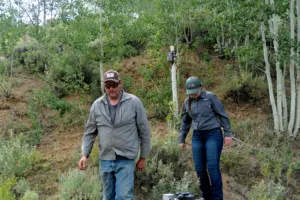
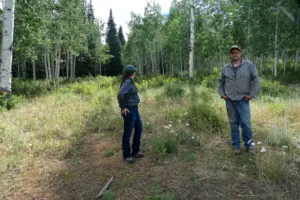
VanValkenburg had his praises for Neiberger.
“Yeah, Shelby’s out here. She’s out here late at night. You know, everything’s harmless right now, but late at night in the dark, you don’t know what’s around here. I’ve been charged by mountain lion, bear, moose, everything around here. So, she’s out here at night and she’s trying to keep herself between our cows and the wolves. And at the same time, being on a four-wheeler not knowing where to go or looking at her phone and OnX, and it’s kind of a hard, hard thing to ask. There’s special people that have to do this. I mean, you’re not gonna come in here thinking, ‘I’m gonna make a lot of easy money just driving around other people’s property.’ You’ve gotta be here at dark and it’s a whole different scenario at dark.”
The Colorado Department of Agriculture reached out to Steamboat Radio News, asking if we would like to meet Shelby Neiberger and interview her to learn more about the range riding program in Colorado.
- CPW Website — Colorado Parks and Wildlife and Colorado Department of Agriculture Range Rider Program is fully staffed, trained and deployed to reduce wolf conflicts
- Colorado Department of Agriculture Website — Range Rider Training
- CPW Website — Tracking Collared Wolf Activity
Long Interview with Range Rider Shelby Neiberger
“Hello. I’m Shelby Neiburger. I work for the Colorado Department of Agriculture, and I am their Northwest Non-Lethal Mitigation Specialist. I’m also a full-time range rider for the state of Colorado. So, what we do when we’re range riding is we focus on areas of wolf activity currently. Wolves have been introduced into Colorado and are hanging around livestock. So our job is to try to protect the livestock and encourage the wolves to leave any areas where there’s a high density of livestock.
That could be, you know, during calving season all the way into the fall, until the cows come home again. We use a lot of different tools. I think a lot of people think that range riding is just out there on your horse being a cowboy, which it is. We do spend quite a bit of time with the livestock, particularly at night when we’re watching them.
Me particularly as a CDA range rider, we have thermal vision to watch the livestock at night. We’re listening for verbal or vocal cues from the livestock themselves because a lot of the times they will let you know if something is in the area that they’re not a fan of. We also use horses and ATVs. We have non-lethal hazing tools like the pepper ball launcher. You can chase wolves on a four-wheeler as long as you’re not making contact with them.
Anybody is able to do that without a non-injurious, non-lethal hazing permit. We can use things like box lights or noise machines. It’s typically the things that people know about. We also get very creative and we come up with different ways, like placing stinky shirts in areas to create that human presence, and maybe marking a human territory to try to keep the wolves out of an area.
Basically anything we can to throw the wolves off and be uncomfortable while they’re near livestock or doing an undesirable behavior. We have three CDA range riders. Currently there’s 10 contracted CPW range riders that work from April to October right now. And then, the CPW damage specialists also help us out with range riding. So, with the CPW contractors, we typically have one or two in each county that’s flexible enough to go to the neighboring county if needed.
And then as CDA range riders, we kind of focus on areas like where there’s packs of wolves or it’s just potential problem areas or it has been a problem area. And then CPW kind of focuses on the same thing we do. It’s a very collaborative effort. We couldn’t do it without the collaboration of the producers or the landowners, because sometimes that’s two different things. Obviously, it doesn’t mean you own the land even if you’re running your cows on it.
So, it’s really important to have that open communication with each other, so as long as we tell them what we’re seeing and if they tell us what they’re seeing, then it helps us paint this picture of what the wolves are doing and kind of helps us build a plan to better attack a situation for the better of it. We use all sorts of techniques and tools to kind of paint this picture of what the wolves are doing.
The CPW, some of them have access to the collar data, which they do share with us. When I say ‘us,’ CDA range riders or their contracted range riders. And that’s sometimes when the wolves and the data points are focusing on an area, and that could mean that they made a kill there or maybe that’s where their den is. And we’ll go investigate that area just to make sure, you know, it’s not a dead livestock animal or anything of concern.
It is delayed. It’s very delayed data, so it is helpful, but it’s just a piece of the pie. Definitely we don’t just solely rely on that data. We are constantly looking for tracks and signs that lets us know, you know, obviously where the wolves are moving, how they’re moving. Just from their feces we can tell even what they’ve been eating and if they’re healthy and stuff like that.
We also rely on game cameras. The game cameras do similar things. They let us know if they’re traveling alone or if they’re traveling as a pack. We got pictures of them packing back food to the dens, and a lot of the times it’s actually small things, like birds or marmots and stuff like that. So even though they do eat large ungulates, they do feast on smaller things as well.
So we use that camera data a lot for that as well, and we’re constantly moving cameras if we’re not getting them because obviously the wolves are usually changing their territory a little bit. I mean, they will travel long, long distances in a short period of time. Even if they have a den, um, when packing particularly, they’ll travel usually like six miles away from their den as the crow flies.
So, they’re going much more than 12 miles in a night. They’ll have a pretty big radius in an area. It it seems like they do like to scavenge a lot too, even off of other predator kills. And then other tools that we use… It kind of depends if we’re trying to get close to the wolves or not. So when we’re trying to create sound, sometimes we’ll hike around with music. Just being creative, or just speaking or human presence thing.
Or if we’re trying to get close to them, we’ll listen to their howling and try to pinpoint at night where we need to go from a direction from there.
Do you get nervous at night doing it by yourself?
I don’t. People ask me this often. They’re like, ‘Are you afraid of the wolves?’ And I’m really not. It’s actually the moose, the moose I’m afraid of because they’re mean, and they’ll go after you.
It doesn’t matter how much. It doesn’t seem like they’re bothered if they’re mad. They don’t care how big you are. So yeah, I’m not afraid of the wolves. You know, up in this country, we can ride four-wheelers. Four-wheelers are loud, there’s lights and everything like that. In other areas that are dense like this behind me where cows are in this tall trees and brush and you can’t hardly see anything, our only options are on horseback or hiking.
And so that’s when I guess it would be… It’s really important to track ourselves, especially if we’re in an area that we don’t know because, one, we want to know where we’ve been so we can tell if it affected the wolves’ movements and if it’s working, and then two, if you’re in a dense forest area, you’ve got to know how to get out. So worst case scenario, if you’re tracking yourself, you can at least backtrack.”
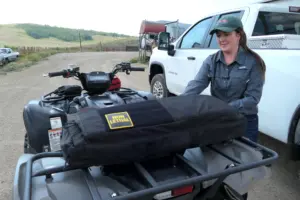
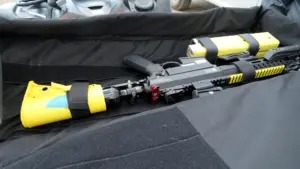
Interview with Shelby Neiberger on Pepper Ball Launcher
“So this is a pepper ball launcher that CDA Range Riders and some of the CPW staff has. It is a non-lethal hazing tool. The reason why we got them actually is because they’re least likely to cause harm to any animals that it’s used with. Law enforcement uses it as well. It’s powered by an air tank and I guess depending on obviously conditions, we can shoot up to like 300 yards.
But we have all been trained on like, you know, depending on those conditions, how far we should go out and just how much air is in the tank and stuff like that matters. We don’t want to haze animals for no reason. We want to associate hazing with an undesirable behavior that the wolves are doing, which that might be, you know, in the middle of a cow herd, harassing the cows would be a good time.
Or if they were especially repeatedly going back to an area that we wouldn’t want them in, that would be an ideal way to catch them. Otherwise, if they’re not going back to the same area, it’s pretty hard to catch them in the act, I guess. So these are the projectiles that the pepper ball launcher uses. They took one of the hottest peppers that they could find and they made a synthetic version of it.
And so there’s just powder in the front of that projectile. So obviously they’re designed to break, so obviously when they hit something, they’re gonna break and you’re gonna see a bunch of powder. Which one of the concerns with them is obviously depending on which way the wind is going. You want to make sure that you’re not downwind of whatever your target is because you don’t want to get that pepper in your face.
But if that does happen, there’s safety precautions and things you can do to obviously to get rid of the pepper on your face.”
Steamboat Radio News Past Coverage of wolves in Colorado
- July 27, 2025 — Meet a Colorado Range Rider – Shelby Neiberger
- July 24, 2025 — CPW reports wolf activity in this month’s watershed map
- July 17, 2025 — CPW updates the four wolf packs in Colorado and settles claims for missing livestock
- July 8, 2025 — CPW Commission and staff discuss Copper Creek Pack
- July 6, 2025 — Holy Cross Cattlemen ask CPW for Chronic Depredation Permit
- July 3, 2025 — CPW Commission receives a new letter about the Copper Creek Pack of wolves
- June 30, 2025 — CPW officials discuss wolves at with Colorado State Legislators at State Capitol
- June 27, 2025 — CPW releases this year’s Colorado Gray Wolf Annual Report
- June 24, 2025 — Colorado Cattlemen hear of new wolf petition being presented to CPW
- June 2, 2025 —Another wolf has died
- May 30, 2025 — Colorado Parks and Wildlife kills a wolf from the Copper Creek Pack
- May 16, 2025 —A gray wolf from British Columbia has died in Northwest Colorado
- April 24, 2025 — Another gray wolf from British Columbia has died
- April 11, 2025, Media Statement: Colorado Gray Wolf 2513 Mortality in Wyoming
- March 29, 2025 — Wolf in Jackson County may be heading to Wyoming
- March 28, 2025 — Wolf in Jackson County meets three Livestock Guardian Dogs
- March 27, 2025 — Day 12 and the wolf keeps showing up each night at the same Jackson County ranch
- March 24, 2025 — Wolf spotted on game cam in Jackson County
- March 22, 2025 — Ballot initiative to end wolf introduction by 2026 has been filed
- March 20, 2025 — A gray wolf recently introduced to Colorado has been killed in Wyoming
- March 19, 2025 — CPW confirms a wolf attack on a dog in Jackson County
- March 5, 2025 — CPW Commission talks wolves and how “we have to get past this point of constant contention”
- Feb. 14, 2025 — Jackson County Rancher says CPW has confirmed a wolf kill of his cow
- Feb. 13, 2025 — Colorado Parks and Wildlife updates wolf movements and more
- Jan. 19, 2025 — Twenty wolves have been released in Eagle and Pitkin counties
- Jan. 16, 2025 — Here is how you can become a Range Rider
- Jan. 15, 2025 — Colorado legislators are told that CPW agents are being threatened
- Jan. 12, 2025 — New wolves may have arrived from British Columbia
- Jan. 11, 2025 — Up to 15 new gray wolves from British Columbia will be in Colorado within two weeks
- Jan. 8, 2025 — Video of the CPW Commission vote, denying the Wolf Citizen Petition
- Jan. 7, 2025 — Ag producers on Ad Hoc Wolf Working Group speak out before Wednesday’s CPW Commission meeting
- Jan. 7, 2025 — STATE LEGISLATORS DISCUSS WOLVES AND THE UPCOMING LEGISLATIVE SESSION
- Jan. 2, 2025 — A reward is offered for the person who shot a gray wolf in Grand County
- Dec. 31, 2024 — Producers submit three wolf depredation claims for over $575,000
- Dec. 23, 2024 — CPW releases definition and stipulations of Chronic Depredation and Lethal Management of wolves
- Dec. 21, 2024 — CPW says they’ll recommend denying petition request for delaying next introduction of wolves
- Dec. 9, 2024 — Colorado Parks and Wildlife has started the operation to bring 15 gray wolves to Colorado from British Columbia
- Nov. 14, 2024 — Wolf Update — November 14, 2024
- Nov. 3, 2024 — A collared wolf has crossed I-70 to the south, for the first time
- Nov. 3, 2024 — CPW responds to requests from Club 20 about Wolf Reintroduction
- Oct. 15, 2024 — Livestock producers have access to livestock protection dogs for free from USDA
- Oct. 11, 2024 — Fifth wolf pup has not been captured
- Oct. 8, 2024 — CPW Commission gets another letter asking to pause wolf reintroduction
- Oct. 6, 2024 — CPW Commission hears wolf updates at meeting
- Sept. 30, 2024 –– A 5th wolf pup is spotted in Grand County and will be captured by CPW
- Sept. 30, 2024 — Colorado Ag Organizations petition CPW Commission before further wolf releases happen
- Sept. 26, 2024 — No producers show for first Non-Lethal Wolf Conflict Reduction Training Meeting
- Sept. 23, 2024 — CPW confirms a cow and a calf killed by wolves in Grand County
- Sept. 16, 2024 — The Wolf Conflict Reduction program is hiring two field specialists
- Sept. 14, 2024 — The next set of wolves coming to Colorado will be from Canada
- Sept. 13, 2024 — Middle Park Stockgrowers ask CPW not to release any more wolves there
- Sept. 12, 2024 — Another wolf is dead in Grand County
- Sept. 10, 2024 — Grand County ranchers are reporting more wolf kills
- Sept. 9, 2024 — The Copper Creek Wolf Pack has been captured and CPW says the adult male was unhealthy and has died
- Sept. 9, 2024 –– Ranchers with the most wolf depredations ask U.S. Fish & Wildlife to take over wolf management
- Aug. 27, 2024 — The Copper Creek Wolf Pack is getting rounded up and relocated
- Aug. 23, 2024 — CPW confirms the next wolves introduced will again be in Northern Colorado
- July 31, 2024 — Eight more sheep confirmed killed by wolves in Grand County
- July 31, 2024 — Colville Tribe says they won’t send wolves to Colorado now
- July 29, 2024 — Two more sheep die from wolves in Grand County
- June 24, 2024 — CPW REPORTS LESS WOLF ACTIVITY IN ROUTT AND NONE IN MOFFAT
- June 20, 2024 — WOLF PUP CONFIRMED IN GRAND COUNTY
- June 19, 2024 — CPW CONFIRMS SOUTH ROUTT WOLF KILL
- June 17, 2024 — PRODUCER REPORTS SUSPECTED WOLF KILL IN SOUTH ROUTT COUNTY
- June 16, 2024 — CPW DIRECTOR JEFF DAVIS ANSWERS QUESTIONS AT JACKSON COUNTY GATHERING
- June 13, 2024 — CPW TO FORM WORKING GROUP REGARDING WOLF RESTORATION
- June 12, 2024 — NORTH PARK PRODUCER WHO LOSES CALF SPEAKS OUT
- June 10, 2024 — CPW CONFIRMS ANOTHER WOLF DEPREDATION IN JACKSON COUNTY THIS WEEKEND
- June 5, 2024 — Wolf Video posted from Grand County
- May 26, 2024 — DON GITTLESON SAYS ANOTHER CALF HAS BEEN KILLED BY WOLVES ON HIS RANCH
- May 15, 2024 — HERE’S THE LATEST LETTER TO MIDDLE PARK STOCKGROWERS FROM CPW DIRECTOR DAVIS
- May 14, 2024 — Suspected mountain lion kills the collared wolf
- May 6, 2024 — MIDDLE PARK STOCKGROWERS SEND EIGHT-PAGE LETTER TO CPW
- April 30, 2024 — GRAND COUNTY RANCHERS TO GET HELP WITH PROTECTING THEIR LIVESTOCK
- April 30, 2024 — NORTH PARK STOCKGROWERS SEND ANOTHER LETTER TO CPW AND GOV. POLIS
- April 28, 2024 —ANOTHER WOLF KILL IN GRAND COUNTY SUNDAY
- April 24-2024 — COLLARED GRAY WOLF ACTIVITY MAP RELEASED FOR APRIL
- April 23, 2024 — A WOLF HAS DIED, AND MIDDLE PARK STOCKGROWERS HEAR FROM CPW
- April 22, 2024 — MULTIPLE LETTERS SENT TODAY TO GOVERNOR POLIS AND CPW ASKING FOR ACTION ON WOLVES
- April 18, 2024 — FOUR MORE HEAD OF LIVESTOCK KILLED BY WOLVES IN GRAND COUNTY
- April 9, 2024 — AG PRODUCERS MEET WITH CPW OFFICIALS IN KREMMLING ABOUT WOLVES
- April 8, 2024 — ANOTHER CALF KILLED BY A WOLF OR WOLVES IN JACKSON COUNTY
- April 3, 2024 — A WOLF OR WOLVES HAVE KILLED A NEWBORN CALF IN GRAND COUNTY
- April 3, 2024 — Denver 7 Calf killed in first confirmed report of gray wolf depredation since wolves were released in December
- Feb. 29, 2024 — COLORADO PARKS AND WILDLIFE OFFICIALS COME TO STEAMBOAT SPRINGS TO TALK WOLVES
- Jan. 30, 2024 — CPW SENDS UPDATE ON WOLF SIGHTINGS SINCE 2004, AND MORE ON THE MAP
- Jan. 24, 2024 — ELECTED OFFICIALS GRILL DEPT. OF NATURAL RESOURCES AND CPW AT HEARING WEDNESDAY
- Jan. 22, 2024 — CPW GETS HARSH LETTER DEMANDING ANSWERS FROM ROBERTS AND MCCLUSKIE
- Jan. 19, 2024 — COLORADO’S NEXT WOLVES TO BE REINTRODUCED WILL BE FROM TRIBAL LANDS IN WASHINGTON
- Jan. 12, 2024 — CPW CONFIRMS WOLVES WERE IN SOUTH ROUTT BUT AREN’T (YET) IN MOFFAT
- Dec. 22, 2023 — FIVE MORE WOLVES ARE RELEASED BY COLORADO PARKS AND WILDLIFE
- Dec. 22, 2023 — CPW DENIES GITTLESON’S REQUEST TO IMPLEMENT 10(J) RULE ON JACKSON COUNTY WOLVES
- Dec. 21, 2023 — THREE OF THE FIVE WOLVES RELEASED IN COLORADO WERE IN PACKS THAT KILLED OR INJURED LIVESTOCK IN OREGON
- Dec. 19, 2023 — LIVESTOCK PRODUCERS RECEIVE WOLF UPDATE FROM CPW IN CRAIG MONDAY
- Dec. 13, 2023 — GITTLESON SAYS ANOTHER CALF WAS ATTACKED BY A WOLF TODAY
- Dec. 11, 2023 — COMPLAINT FILED IN U.S. DISTRICT COURT TO STOP WOLF REINTRODUCTION IN COLORADO
- Dec. 4, 2023 — KEEP YOUR PETS CLOSE AND CARRY A BIG STICK – CPW HAS ADVICE FOR LIVING WITH WOLVES
- Nov. 19, 2023 — THREE LAMBS KILLED BY A WOLF IN JACKSON COUNTY, SAYS RANCHER
- Nov. 17, 2023 – CPW AND CDA ANNOUNCE AGREEMENT TO WORK TOGETHER ON WOLF REINTRODUCTION
- Nov. 7, 2023 – U.S. FISH AND WILDLIFE SETS DATE FOR 10J RULE FOR WOLVES
- Oct. 6, 2023 – COLORADO WILL RECEIVE WOLVES FROM OREGON
- May 16, 2023 – POLIS VETOES 10J RULE WOLF BILL
- May 3, 2023 – CPW COMMISSION APPROVES FINAL WOLF RESTORATION AND MANAGEMENT PLAN
- May 2, 2023 – MANAGEMENT OF GRAY WOLVES REINTRODUCTION BILL PASSES IN STATE HOUSE
- May 2, 2023 –CPW MEETS THIS WEEK FOR FINAL WOLF MANAGEMENT PLAN
- April 27, 2023 – CPW CONFIRMS WOLF SIGHTING EAST OF KREMMLING
- April 8, 2023 – CPW WOLF COMMISSION MEETS IN STEAMBOAT SPRINGS
- April 3, 2023 – CPW TO PRESENT FINAL DRAFT WOLF RESTORATION AND MANAGEMENT PLAN IN STEAMBOAT SPRINGS
- March 28, 2023 – THE SOUTHERN UTE TRIBE ASKS THAT CPW RELEASES WOLVES ALONG I-70 CORRIDOR
- March 15, 2023 – TWO DOGS DIE FROM WOLVES IN JACKSON COUNTY THIS WEEK
- March 3, 2023 –COLORADO PARKS AND WILDLIFE COMMISSION RELEASES WOLF REINTRODUCTION MEETING RECAP
- Feb. 21, 2023 —WOLF 2101 RECAPTURED AND RECOLLARED IN JACKSON COUNTY
- Feb. 21, 2023 —10J RULE MEETINGS WITH REGARDS TO WOLVES SCHEDULED FOR NW COLORADO BY US FISH AND WILDLIFE
- Jan. 17, 2023 —STATE LEGISLATORS HEAR MORE ON WOLF REINTRODUCTION AT JOINT COMMITTEE HEARING
- Dec. 13, 2022 —MORE WOLVES VISIT GITTLESON PROPERTY IN JACKSON COUNTY THIS WEEK
- Dec. 12, 2022 —NORTH PARK RANCHERS MEET WITH CPW REGARDING WOLF REINTRODUCTION PLAN
- Dec. 10, 2022 —CPW RELEASES DRAFT COLORADO WOLF RESTORATION AND MANAGEMENT PLAN
- Nov. 19, 2022 —ANOTHER WOLF ATTACK REPORTED IN JACKSON COUNTY
- Oct. 9, 2022 —WOLVES ATTACK CALVES IN RIO BLANCO AND JACKSON COUNTIES
- July 14, 2022 —CPW UPDATES THE WOLF PACK IN JACKSON COUNTY
- June 20, 2022 ––WOLF MANAGEMENT DISCUSSED AT MEETING IN WALDEN
- June 15, 2022 —WOLVES IN NORTH PARK ARE SUBJECT AT MEETING MONDAY, JUNE 20
- May 30, 2022 —THE GITTLESON RANCH LOSES ANOTHER CALF TO WOLVES, THEY SAY
- May 5, 2022 —AT LEAST TWO MORE CALVES KILLED BY WOLVES ON GITTLESON RANCH
- May 10, 2022 ––THIRD CALF DIES ON JACKSON COUNTY RANCH; CPW DOES NECROPSY
- April 11, 2022 —A NEW LITTER OF WOLF PUPS IS EXPECTED IN JACKSON COUNTY
- March 17, 2022 —WOLVES ATTACK ANOTHER DOMESTIC COW IN JACKSON COUNTY
- Feb. 10, 2022 – MONTANA STOCKGROWERS VOICE SUPPORT FOR COLORADO RANCHERS OVER THE WOLVES
- Feb. 9, 2022 – WOLF MANAGEMENT DISCUSSED BY LOCAL RANCHERS AND OFFICIALS AT FORUM IN STEAMBOAT
- Jan. 22, 2022 – WOLF MITIGATION OPTIONS
- Jan. 19, 2022 – ANOTHER COW KILLED OVERNIGHT IN NORTH PARK BY WOLVES
- Jan. 18, 2022 – TWO MORE COWS ATTACKED BY WOLVES IN JACKSON COUNTY TUESDAY
- Jan. 12, 2022 – CPW ALLOWS WOLVES TO BE HAZED IN EMERGENCY DECLARATION
- Jan. 10, 2022 – A WOLF PACK KILL IS REPORTED IN JACKSON COUNTY OVER THE WEEKEND
- June 9, 2021 – WOLF DEN WITH PUPS CONFIRMED IN NW COLORADO
